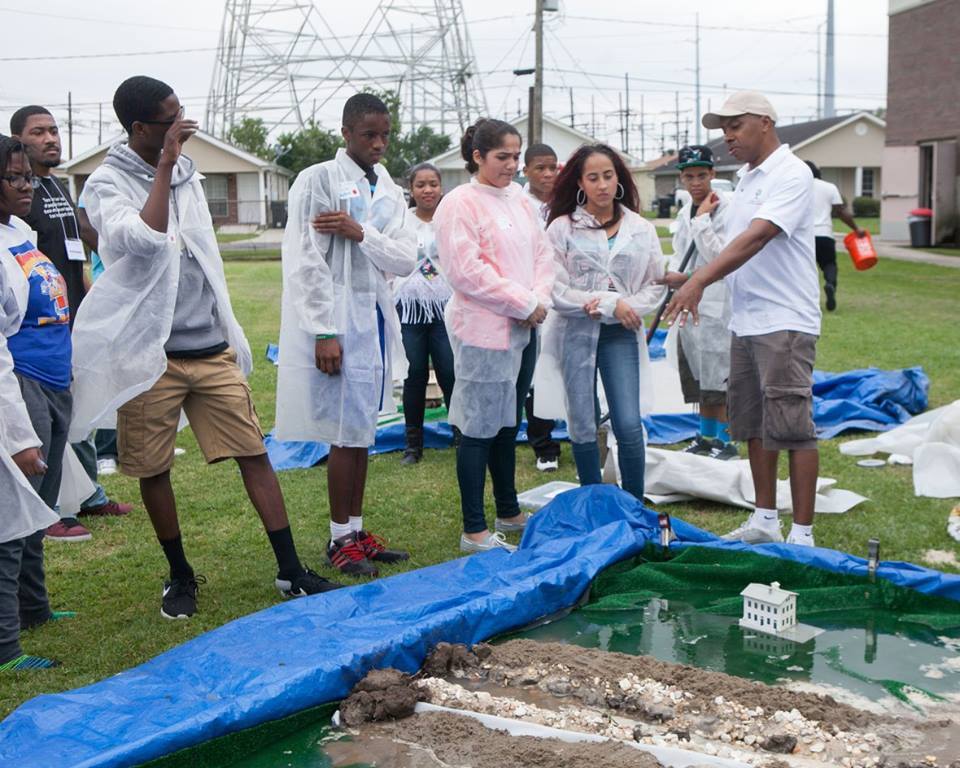
“In the 21st century, our children have one of three options: take something, break something or make something,” says New Orleans native Calvin Mackie, engineer and founder of the nonprofit STEM NOLA, which conducts hands-on science projects, mainly in New Orleans. (STEM refers to Science, Technology, Engineering and Mathematics.)
“If we don’t give them the skills and education to make something,” he continued, “then we leave them with the two options we see on the news every night.”
As of May 31, there were 300 shooting victims in New Orleans. In 2015 and 2016, it took two months longer to hit that dubious target. New Orleans is on pace to suffer a record year. Thirteen people were shot on June 3 alone, which according to New Orleans crime analyst Jeff Asher, is the per-capita equivalent of 90 people in a day in Chicago.
When school is out, kids are vulnerable to violence, especially in neighborhoods where the shortsightedness of “an eye for an eye” justice must be unlearned. Students need safeguards, and a quality education is a proven buffer. School hours are the safest for children. From the time students get on the bus to go to school till the last bell rings, fewer crimes are committed against and by youth.
While I’m a proponent of year-round school and look forward to a modernized school calendar, shielding students by locking them up in a school building all year isn’t the answer. (Though schools that shut playground gates in the summer could easily leave them open when not in session.)
But if we’re really trying to reduce shootings, crime and violence, the focus has to go beyond what happens inside a school. Quality teachers, programs and initiatives must go where beef is being cooked: outside the classroom.
“Education is not preparation for life; education is life itself.” — John Dewey
Education takes away the oxygen that allows the fire of violence to burn. Just as it’s easier for students to learn French by speaking it in France, we need civics, literature and science to be practiced in communities rocked by nonsensical violence. We must create opportunities to practice what students learn in schools. And New Orleans, which experienced the greatest engineering disaster in U.S. history when the levee system broke in the aftermath of Hurricane Katrina, could stand to produce a few engineers from the hood.
STEM NOLA and its leader Mackie are adding to the educational landscape when school is officially closed, and simultaneously remediating dangerous spaces that breed violence. The stated purpose of the group is “to expose, inspire and engage members in the surrounding communities about the opportunities” in STEM subjects.
In churches, community centers and the streets, Mackie’s STEM Saturdays have seen hundreds of students build model cities and levees to teach about coastal erosion and hurricane protection. “In New Orleans, it doesn’t make sense to teach certain scientific concepts through a volcano when you can use Lake Pontchartrain,” Mackie says, referring to the body of water that surged and flooded much of the city during Hurricane Katrina. “Education has to be portable, organic and relevant.”
For instance, Mackie had youth gather by age group to construct motorized boats under the supervision of engineers and professional builders. This summer, STEM NOLA has already serviced seven different camps, engaging 600 kids in hands-on activities. In total, more than 10,000 students worked on STEM activities in the past three-and-a-half years, when children were out of school.
Ironically, Mackie developed STEM NOLA after the state of Louisiana denied him permission on four separate occasions to start a STEM-themed school. (His was one of several community-based applications the state rejected during a critical period in New Orleans’ charter expansion.) The black community collectively shook its head. If a former tenured professor of engineering at Tulane University can’t get approved to manage a charter school, something is wrong. “It’s obvious there’s an agenda that appears not to support community groups,” James Raby of the Cohen Alumni Association, a community group that unsuccessfully sought to manage a charter school, told The Times-Picayune in 2010.
We need more positive out-of-school opportunities. That’s why President Trump’s $1.6 billion proposed budget cut to after-school and summer programs stokes the fire of violence. In defense of the cuts to 21st Century Community Learning Centers, Office of Management and Budget Director Mick Mulvaney said after-school programs don’t “show results.” We can quibble over how we define effectiveness and success for after-school programs, but taking away their funding ignores the fact that kids spend most their time out of school and low-income families have fewer options to fill the time.
Instead of cutting back, we need to devote more resources to libraries, mobile schools, recreational activities, dance programs and other services that can operate in violent hot spots. The idea that education can only be found in a brick-and-mortar school is as myopic as the idea that we can jail our way to safety.
Schools aren’t going to teach French better than living in France — meaning, we shouldn’t look to schools as our only or even primary source of learning. Education philosopher John Dewey said it best: “Education is not preparation for life; education is life itself.” We need to fill the classrooms of our daily lives with varied kinds of learning; if not, in certain communities, violence may fill the vacuum.
Andre Perry, PhD, is a New Orleans educator and the host of “Free College” on WBOK 1230 radio, Tuesdays at 3 p.m. Tweet him @andreperryedu
This column is being published simultaneously by the The Hechinger Report, a nonprofit, independent news organization focused on inequality and innovation in education. Perry is a Hechinger contributing writer.
The opinion section is a community forum. Views expressed are not necessarily those of The Lens or its staff. To propose an idea for a column, contact Lens founder Karen Gadbois.


